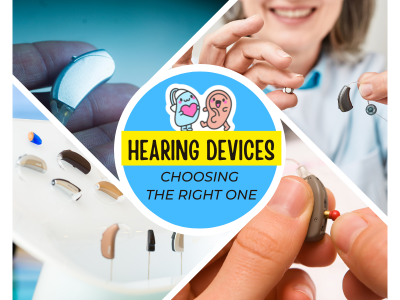Our Hearing Blog

Are All Hearing Devices Created Equal? Unraveling the Differences
Do you find yourself struggling to hear conversations or missing out on the sounds around you? If so, you're not alone. Hearing loss is a common challenge, but fortunately, there are various hearing devices available to help make your world sound clear and vibrant again.
Whether you’re exploring options for the first time or reassessing your current hearing aid, it’s essential to know that not all hearing devices are the same. Each type of device has unique features that cater to different levels and types of hearing loss. Let's dive into the different types of hearing devices out there and discover what sets them apart!
Understanding the Different Types of Hearing Devices…
1. Behind-the-Ear (BTE) Hearing Aids
These handy devices sit comfortably behind your ear and use a custom mold or thin tubing to deliver sound. BTE hearing aids are versatile, accommodating a wide range of hearing loss— from mild to severe. They are user-friendly but require some dexterity to handle.
2. In-the-Ear (ITE) Hearing Aids
ITE hearing aids fit directly in the outer ear, either filling it completely or partially. This design is especially suitable for individuals who may struggle with fine motor skills, making them easier to handle. They work well for those with moderate to significant hearing impairment.
3. Receiver-in-the-Ear (RITE) Hearing Aids
RITE devices are similar to BTE aids but feature a slim wire that leads the sound to a receiver placed in the ear canal. This design offers a natural sound experience and is ideal for those with mild to severe hearing loss. These aids also require good dexterity.
4. In-the-Canal (ITC) Hearing Aids
Less visible than other options, ITC hearing aids sit deep in your ear canal. Their smaller size can make them trickier to handle, but they are an excellent choice for those dealing with moderate to severe hearing loss.
5. Completely-in-the-Canal (CIC) Hearing Aids
Even smaller than ITC devices, CIC hearing aids fit deeper in the ear canal, making them almost undetectable. They’re tailored for individuals with more pronounced hearing impairments.
6. Cochlear Implants
For individuals with nerve-related hearing loss, cochlear implants can be life-changing. These surgically implanted devices stimulate the nerves in the inner ear, helping those with moderate to severe hearing loss experience sound.
7. Bone Anchored Implants (BAHA)
BAHA devices provide a unique solution for conductive hearing loss. They transmit sound through the bones of the skull directly to the inner ear, bypassing issues in the outer or middle ear.
The Power of Features and Technology in Hearing Devices…
Modern hearing devices come equipped with a wealth of advanced features designed to enhance your listening experience. Given the wide variety of features available, consult with an audiologist or hearing instrument specialist to find a device that suits your lifestyle and hearing needs.
Some innovative options include:
- Rechargeable Batteries: Say goodbye to disposable batteries!
- Analog vs. Digital Technology: Choose based on your comfort and needs.
- Wireless Connectivity: Stream audio directly to your hearing aids from smartphones and other devices.
- Directional Microphones: Focus on specific sounds in noisy environments.
- Noise Reduction and Speech Enhancement: Enjoy clearer conversations without background distractions.
How to Choose the Right Hearing Device for You…
Choosing the best hearing device can feel overwhelming, but you don’t have to do it alone! Work with a hearing instrument specialist who can guide you through your options. Consider your unique hearing needs, lifestyle, and even your budget—some devices can be quite an investment.
Seeing a Hearing Instrument Specialist…
It's crucial to understand how each device works and how they'd fit into your daily routine. Traditional hearing aids cater to various needs, while newer options like cochlear implants have revolutionized support for those with more severe hearing challenges. Don’t forget about the emerging over-the-counter options too, which can also assist folks with mild hearing loss.
By educating yourself about the different types of hearing devices and their unique features, you’ll be better prepared to make informed decisions that will improve your quality of life. Ready to explore your options? Let’s make hearing loss a thing of the past together!
Blog Archive

